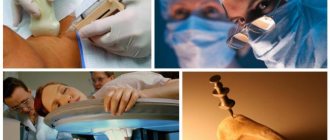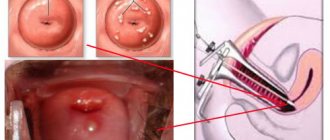| Appointment with a gynecologist in Moscow on the day of treatment | Reception is strictly by appointment, make an appointment by phone: +7 | Prices for services | Reviews about the clinic |
Contraindications to colposcopy
, do they exist and what could they be? This is of interest to many women due to the fact that this instrumental study is prescribed quite often. Especially when it comes to diseases that lead to pathological changes in tissue on the cervix or vaginal walls.
It is worth noting that colposcopy is an indispensable method for detecting early symptoms of many diseases, including precancerous conditions, cancer and human papillomavirus infection. However, the procedure can be used not only for diagnosis, but also, for example, to monitor changes in lesions or determine the site for a biopsy.
Make an appointment with a gynecologist by phone or by filling out the online form
| Select a clinic | Pelvic ultrasound | Tests for STIs | Cervical erosion |
Useful information on the topic:
- Videocolposcopy
- Colposcopy during pregnancy
- Colposcopy of the cervix
- Indications for colposcopy
- Colposcopy
- Extended colposcopy
Colposcopy technique
Colposcopy with a smear for oncocytology is the main method for the prevention and diagnosis of precancerous diseases and cancer of the cervix, vagina and external genitalia.
The colposcope is a microscope adapted for this study, which allows one to examine pathological changes in the cervical mucosa under various magnifications.
Modern colposcopes are equipped with devices for receiving and storing photo and video information. This allows the doctor and patient to evaluate the results of treatment over time and consult with other specialists without repeating the study.
A doctor who has an idea of the symptoms of the disease and knows its colposcopic picture can make a preliminary diagnosis with an accuracy of 70-80%. In combination with cytological and histological examination, the material for which is taken during colposcopy, the accuracy of the diagnosis increases to 100%.
Colposcopy is routinely performed in the middle of the menstrual cycle, from 9 to 21 days.
The procedure is performed on a gynecological chair in a gynecologist's office, is short (5-10 minutes) and painless. With the help of a speculum, the walls of the vagina are moved apart, and the cervix becomes accessible for inspection.
First, a general examination is carried out and a smear is taken for atypical (cancerous) cells. At this stage, the doctor evaluates the shape of the cervix, identifies its deformations, ruptures, inflammatory processes and takes a smear for cancer cells for cytological examination.
Then tests are carried out, the purpose of which is to identify hidden lesions of the epithelium of the cervix, vagina and external genitalia, to clarify their size, location and nature. The test consists of examining the mucous membrane after treating it with a 3% solution of acetic acid and Lugol's solution (Schiller test).
Back to contents
Video of cervical colposcopy
In modern conditions and with the current development of digital and computer technology, colposcopy of the cervix is often performed with photo and video recording of the results. Saving the examination results serves as an assistant to the gynecologist to monitor changes or monitor the development of pathological processes of the cervix, especially those that are prone to relapse - erosion and dysplasia of the cervix.
Since even the most attentive doctor does not have such a phenomenal memory to remember the previous results of examining the uterus and mucous membrane of each of his patients, recording the results of colposcopy is even more relevant if you have to contact different gynecologists.
In addition, comparison of photo and video materials before and after the prescribed treatment allows the gynecologist to evaluate and see the effectiveness of the treatment.
Below we offer a video for viewing that clearly and clearly explains the concept of cervical colposcopy and the need for the procedure:
Why is colposcopy needed?
Indications for colposcopy
There are no absolute contraindications for performing colposcopy.
Colpovulvoscopy is included in the list of mandatory studies during preventive medical examinations and should be carried out routinely for every woman once a year. Prescribed in the following clinical situations:
- Cervical biopsy (must be performed under colposcopic guidance)
- Contact (after sexual intercourse) bleeding from the genital tract
- Human papillomavirus (HPV) infection of the genital organs
- Suspicion of precancerous and oncological processes of the genital organs
- Inflammatory processes: cervicitis, vulvitis, colpitis
- Dynamic monitoring of the cervical treatment process
- Before surgical treatment, pregnancy planning, before IVF
The initial stages of cervical cancer are asymptomatic and examples are not uncommon when cervical cancer is an accidental finding. The cervix is not accessible for independent examination, like the mammary glands or external genitalia, and only a gynecologist can do this.
Back to contents
Preparing for colposcopy
Colposcopic examination is not prescribed during menstruation. Also, the procedure is not recommended during the ovulatory period, since heavy mucous discharge may interfere with the examination. The optimal time for colposcopy is 2-3 days before the start of menstruation or 3-4 days after its completion.
In addition, for several days before the study, a woman should adhere to the following recommendations:
- Do not douche, such procedures can disrupt the vaginal microflora, which will affect the results of cervical colposcopy;
- Refrain from sexual contact;
- Do not use vaginal suppositories, tampons, or creams.
Immediately before colposcopy, it is necessary to perform genital hygiene.
Video colposcopy and colposcopic images
Vinegar test
Healthy cervix after treatment with 3% acetic acid. Cloudy mucus is visible. the surface of the mucous membrane is smooth and transparent.
Schiller test
The same neck after treatment with Lugol's solution. The mucous membrane (stratified squamous epithelium) was evenly stained dark brown.
Symptom "Pupil"
Healthy cervix in the middle of the menstrual cycle. At this time, the cervical canal contains a large amount of mucus, due to which the external pharynx expands and takes on a rounded shape - a symptom of a “pupil”.
Cervical erosion
Cervix with ectopic columnar epithelium before and after treatment with 3% acetic acid and Lugol's solution.
- “Erosion” - ectopia of columnar epithelium
- Test with 3% vinegar
- Test with Lugol. The columnar epithelium was not stained because its cells do not contain glycogen
Cervical cyst
Dilated vessels are visible through the thinned mucous membrane of the cyst wall.
Condylomas on the mucous membrane of the vestibule of the vagina
Papilloma on the skin of the perineum
Why is a cervical colposcopy performed?
When performing a procedure such as cervical colposcopy, harmful pathological conditions of the cervix can be detected, such as:
- cervical erosion;
- endometriosis;
- dysplasia;
- ectopia;
- erythroplakia;
- developed HPV (human papillomavirus);
- gynecological polyps;
- precancerous or cancerous conditions.
Taking into account the danger of possible diseases for the patient’s health and the effectiveness of treatment with early diagnosis, colposcopy should be performed for preventive purposes at least every year.
But a mandatory indication for this examination is the appearance of the slightest signs of an unhealthy condition of the woman’s reproductive organ.
If, during a routine examination by a gynecologist, the doctor discovered a suspicious area of the cervix, this will also serve as an indication for colposcopy immediately (if the patient is ready for this type of procedure) or an appointment will be made as soon as possible for the woman’s return visit to carry out the planned procedure.
Also necessary for colposcopy of the cervix are the following patient complaints:
- causeless and constantly felt discomfort in the lower abdomen;
- pain during sexual intercourse;
- bleeding that has begun;
- non-cyclical bleeding;
- other strong vaginal discharge.
When is the best time to do a colposcopy?
The examination is not carried out either during menstruation or during any other bleeding from the vagina. It is not advisable to carry out the procedure in the middle of the menstrual cycle, when cervical mucus is abundantly released as a result of the ovulation process.
The procedure is prescribed 2 weeks before menstruation, in the first phase of the menstrual cycle (first 5-7 days), when the mucus in the cervical canal is transparent and allows for a more accurate assessment of the condition of the tissues.
Types of colposcopy
Using a colposcope, you can carry out both a simple examination and the use of medications (reagents).
Types of extended colposcopy are divided according to the type of reagent used:
- Use of acetic acid. When exposed to this substance, healthy blood vessels begin to narrow. But if there is a suspicion of any pathology, then the effect will be exactly the opposite.
- Application of Lugol's solution. Pathogenic areas are not stained; the affected area requires a biopsy.
- Application of a solution of iodine and potassium. The reaction to the depth of staining is considered.
- Fluorochromes are used to diagnose cancer cells. After staining with this substance, ultraviolet irradiation is performed; the affected cells have a pink tint.
- Application of Chrobak's test. A probe is used for research; if bleeding occurs when it is pressed on a suspicious area, then neoplasia can be diagnosed with accuracy.
- The samples taken with adrenaline are the least common.
Colposcopy during pregnancy
During pregnancy, colposcopic examination should only be prescribed as a last resort. This is due to the fact that after the intervention it is possible to provoke bleeding and even premature birth (in the early stages - termination of pregnancy). Therefore, it is better to postpone the procedure to another time, when the baby is born.
Colposcopy itself does not harm either the fetus or the mother. But in order not to take risks due to a woman’s reduced immunity during pregnancy, the examination is postponed. Only in rare cases, when a pathology of the cervix is detected, is urgent treatment prescribed even before the onset of childbirth. In this case, colposcopy is performed very carefully.
How is the examination procedure performed using a colposcope?
The duration of the procedure is from 20 to 40 minutes. As already mentioned, the examination is performed on a gynecological chair. The colposcope is installed at a distance of 10-15 centimeters from the genital slit. The doctor exposes the cervix using vaginal speculum, and then removes mucus using cotton swabs. Next, using a colposcope, he examines the vaginal part of the woman’s cervix. In this case, the light beam is directed perpendicularly. This is a simple colposcopy that is non-contact and therefore painless. After a simple colposcopy, the doctor performs an extended one. First, he applies various solutions to the mucous membrane, changing the color of the epithelium depending on the nature of the research. This makes it possible to identify the boundaries of the affected areas of the epithelium. This examination, as mentioned earlier, allows you to study the pathology of the cervix, determine the nature and even possible causes of these pathologies, exclude or, conversely, suspect precancerous or cancerous conditions. The results of colposcopy are assessed immediately upon completion. As a result, a protocol for each specific study is drawn up, in which a photograph or, if necessary, a video recording is filed. After the doctor makes a medical report, he prescribes a course of treatment or refers you for additional examination.
What are the contraindications to colposcopy?
This procedure is completely safe, it does not cause any harm to the body, which is why it is prescribed to women during pregnancy, since there are no special contraindications to its implementation.
Colposcopy is not performed only after childbirth in the first six to eight weeks, and also during this period it is not performed after a course of treatment of the cervix, which was performed destructively or surgically.
The only contraindication to performing extended colposcopy is individual intolerance to acetic acid or iodine.
Extended colposcopy
The use of various substances to change the condition of blood vessels and improve the visualization of pathological changes in tissues involves extended colposcopy. Diagnostic tests used:
- with acetic acid. To get a more informative picture, the cervix is treated with a 3% solution of acetic acid, which causes vascular contraction and swelling of the mucous membrane for a short time;
- with Lugol's solution (consisting of 1% iodine and 2% potassium iodide), during treatment of which healthy tissues turn brown and pathological tissues are clearly visualized with whitish spots against their background.












